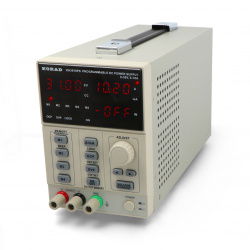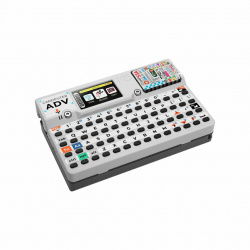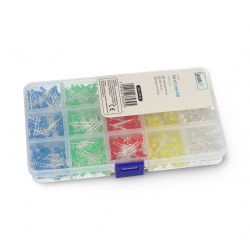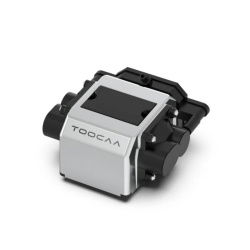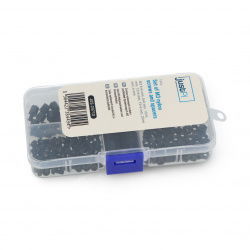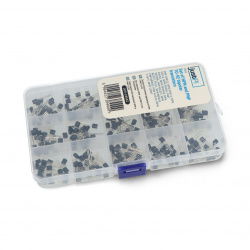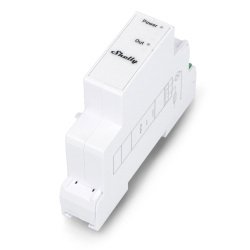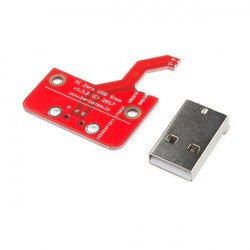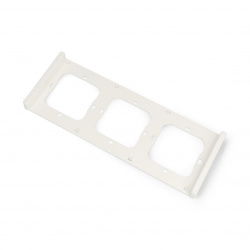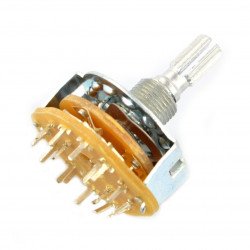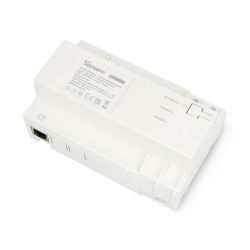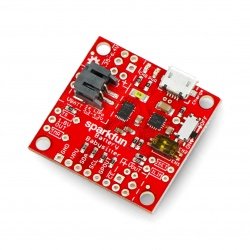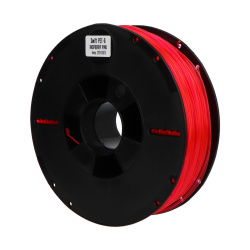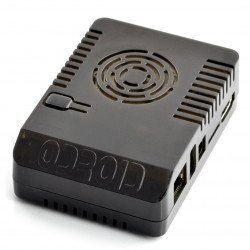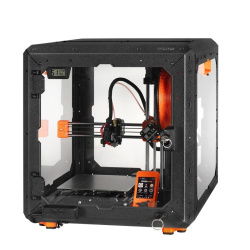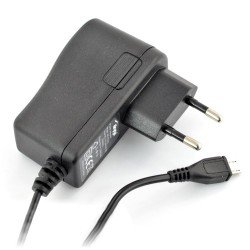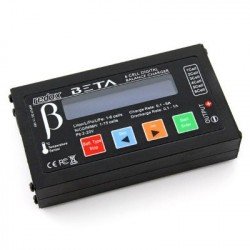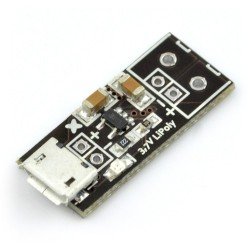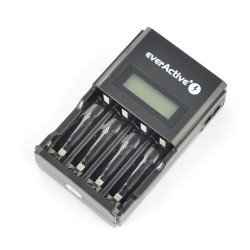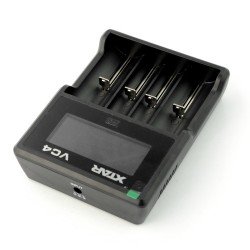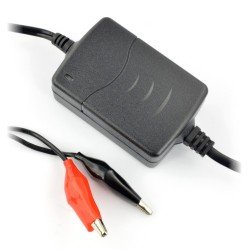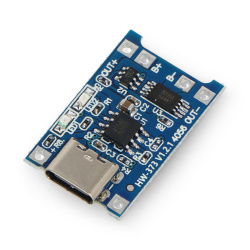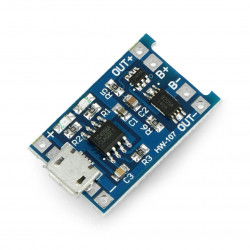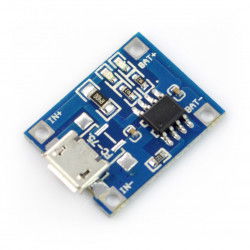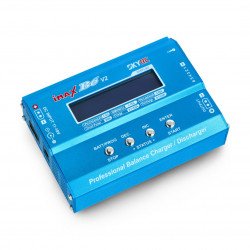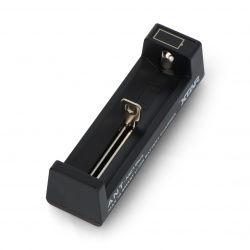Many devices are powered by batteries, but they require recharging of the energy they lose when using them. To provide them with the missing energy, we use chargers that are well known to us from mobile phones, tablets, laptops or cameras. The chargers are also designed to charge automotive gel batteries, as well as lithium-polymer, lithium-ion and nickel-metal-hydride cells. The market of chargers is constantly developing. Today we can choose not only traditional chargers, which have a cable and need access to an electrical socket and require direct connection to the device being charged, but also modern induction chargers. Both variants can be found in our offer. The chargers are very versatile in use. Very often we use one of them for several different devices. However, it is worth checking beforehand whether the input fits the specific equipment and meets its requirements in terms of technical parameters.
Chargers
Li-Ion charger HW-373 v1.2.1 TP4056 1S 3,7V USB type C with protection
Charger for single-cell 3.7V lithium-ion batteries. The module is based on the TP4056 chip . The system is powered via a USB Type-C connector or optionally via cables...Li-Ion charger TP4056 1S 3,7V microUSB with protection
A simple charger for single-cell lithium-ion batteries with a nominal voltage of 3.7V. The system is powered via a microUSB connector or via cables. The module is protected...Li-Ion charger TP4056 1S 3,7V miniUSB
A simple charger for 1-cell lithium-ion batteries with a nominal voltage of 3.7 V. The system is powered via a miniUSB connector or via cables.Li-Ion charger TP4056 1S 3,7V microUSB
A simple charger for 1-cell lithium-ion batteries with a nominal voltage of 3.7 V. The system is powered via a microUSB connector or via cables.Li-Pol / Li-Ion / Li-Fe / Ni-Cd / Ni-MH charger with SkyRC IMAX B6 v2 balancer
Loader/unloader with built-in cell balancer. Supports LiPo, LiIon, LiFe, NiCd, NiMH and Pb cells and packages.Battery charger 18650 - XTAR MC1 +
Universal mains charger for cylindrical Li-ion batteries. Supports battery sizes 10440, 14500, 14650, 16340, 17335, 17500, 17670, 18350, 18490, 18500, 18650, 18700, 20700,...Adapter C/D R14/R20 for the NC-3000 everActive charger
Adapter for charging R14 (C) or R20 (D) batteries with the NC-3000 or MH-C9000 charger.DFRobot DFR0580 - Solar Power Manager For 12V Lead-Acid Battery
Module designed for renewable energy and IoT projects. It has 5 power leads - ARK 12 V for charging lead acid batteries, ARK 12 V, ARK 5 V and 2 USB with 5 V. It works with...Wall socket 250V charger 2x USB 45x45mm 2,1A - white
Flush-mounted socket module equipped with two 2.1 A USB sockets in white, Lanberg brand. Designed for mounting in frames equipped with supports, floor boxes, wall boxes....DFRobot MP2636 Power Booster & Charger Module - Li-Ion / Li-Pol charger module - 6V / 2.5A
Battery charger module for 1-cell Li-Ion or Li-Pol batteries with a nominal voltage of 3.7 V . The charging voltage is from 4.5 V to 6 V, the maximum charging current is...Charger Li-Pol/Li-Ion/Li-Fe/Ni-Cd/Ni-MH with balancer SkyRC IMAX B6 mini USB
Loader/unloader with built-in cell balancer. Supports LiPo, LiIon, LiFe, NiCd, NiMH and Pb cells and packages.Power supply 3x USB type A - 5V 3,1A - Akyga AK-CH-05
Power supply with three A-type USB outputs. Output voltage 5 V, maximum current efficiency 3.1 A. The set does not include a USB cable, it can be purchased separately.Battery LCD charger XTAR MC2 18650
Universal mains charger for Li-ion cylindrical batteries. Supports 14500, 14650, 16340, 17500, 17670, 18350, 18500, 18650, 18700, 22650, 25500, and 26650 battery sizes. Power...XTAR MC2 Plus charger for 18650 batteries
Universal mains charger for Li-ion cylindrical batteries. Supports 14500, 14650, 16340, 17500,17670, 18350, 18500, 18650, 18700, 20700, 21700, 22650, 25500, and 26650...Battery Babysitter - LiPo Battery Manager - SparkFun PRT-13777
The module is designed for 1-purpose lithium-polymer batteries. It combines the functions of a charger and a battery monitoring module. It allows to power the system in a safe...- Sale
- SPECIAL OFFERS
Battery LCD charger XTAR VC2 18650
Universal mains charger for Li-ion cylindrical batteries. Supports 14500, 14650, 16340, 17500, 17670, 18350, 18500, 18650, 18700, 22650, 25500, and 26650 battery sizes. Power...Li-Pol / Li-Fe/Li-HV/Ni-MH Charger SkyRC E450
Easy to use SkyRC E450 mains LiPo charger with balancer. Powered by 230V mains voltage. Used to charge 2-4 cell Lithium-Polymer (LiPol, LiHV), Lithium-phosphate (LiFe) and...Power supply Argon40 USB type C 5.25V / 3.5A for Raspberry Pi 4B - black
The power supply is equipped with a USB type C plug and is compatible with the Raspberry Pi 4B minicomputer. It has parameters that allow for optimal power supply of the...Charger BFF - charging module Li-Pol/Li-Ion - add-on for QT Py - Adafruit 5397
The Charger BFF module is equipped with a charger system for Li-Pol and Li-Ion MCP73831 batteries . The board is mounted directly on the pins of modules from the Adafruit...MCP73831 - Li-Pol/Li-Ion charger single 1S 3,7V USB cell - Adafruit 1304
Charger for 1-purpose lithium-polymer batteries with a nominal voltage of 3.7 V and lithium-ion. The circuit is powered by a USB plug, which can be plugged directly into a...BATT-MAN Click - power manager - LTC3586 - Mikroe MIKRO-2901
The BATT-MAN Click module produced by Mikroe serves as a power manager . Enables monitoring and protection of various power sources, including lithium-ion Li-Ion and lithium...- Sale
- SPECIAL OFFERS
Solar USB/DC charger for Li-Ion and Li-Pol batteries - Adafruit 390
Charger for single-cell Li-Ion or Li-Pol batteries powered from a USB type C socket or DC 5.5 / 2.1 mm connector with the possibility of connecting a solar cell . The...SenseCAP Card Tracker T1000-E charging module - PCBA with 6 magnetic wires - Seeedstudio 114993534
Dedicated charging module designed specifically for SenseCAP Card Tracker T1000-E . Thanks to the PCBA board and six magnetic wires, it allows simultaneous charging of up...Battery charger everActive NC1600 - AA, AAA 1-16pc
Microprocessor-based mains charger, supporting Ni-MH (nickel-metal hydride) rechargeable batteries. It is possible to charge from 1 to 16 R6/AA or R03/AAA rechargeable...See also
Power, car or induction. Which charger should I choose?
The chargers differ in the way and possibility of use. Some will need access to a socket for use, others will be used in the car, and still others in any place where necessary. Network chargers are the most popular and currently we use them most often. We can use them to charge electronic devices by plugging them into an electrical outlet. For this reason, we will use them only where there is an electrical outlet. There are also chargers, which have an additional detachable USB cable, thanks to which we can charge the device using the USB port, e.g. in a computer. When you are on the road or often driving a car, it is worth having a car charger with you. Plug it into the cigarette lighter socket. You should know, however, that in most cases you will only charge the device in the car when you insert the ignition key and start the vehicle. A modern and very practical solution is an inductive charger. This allows you to charge your device wirelessly, i.e. in any convenient way, without the need to connect the device directly to the charger with a cable. Induction charger is usually in the form of a flat pad, which in turn is equipped with a power cable. We place the device on the pad and connect the pad with the cable to an electrical outlet. All you need to do is make direct contact between the device and the charger to be able to replenish the energy deposits in it.
Key parameters of the charger
Some people probably remember that time when only certain models of chargers fit into each device, and even every manufacturer designed their devices so that they were only compatible with the chargers that were included in the sets. Today, however, we have more freedom to charge electronic devices, which we owe to the unification of chargers to the micro USB standard, although there are still devices that we do not charge in this way. This means that we can charge most models of smartphones, tablets, cameras and e-book readers with one charger. When choosing a charger, however, you need to pay attention to several important parameters and features. The charging voltage, which is expressed in V (Volts) is very important. We must also take into account the current, which in turn is expressed in A (Amps). We also cannot be sure that the identical micro USB connector will allow for safe charging of our device. We must remember that higher current translates into lower battery life. At the same time, however, the higher the intensity, the shorter the charging time. For a longer equipment life, a slower charging practice works better in most cases. This applies especially to Li-Ion batteries. Does this mean that we should not use fast chargers at all? If we use this option only occasionally, when we are short of repair time, we should not be afraid that our device will stop working properly prematurely. However, we try to avoid intensive and short charging on a daily basis.






























































































































































































































































































































